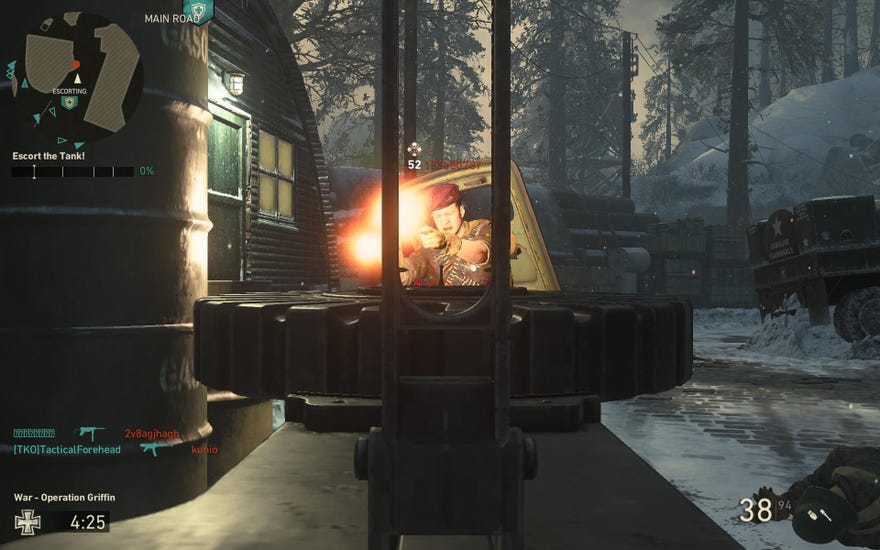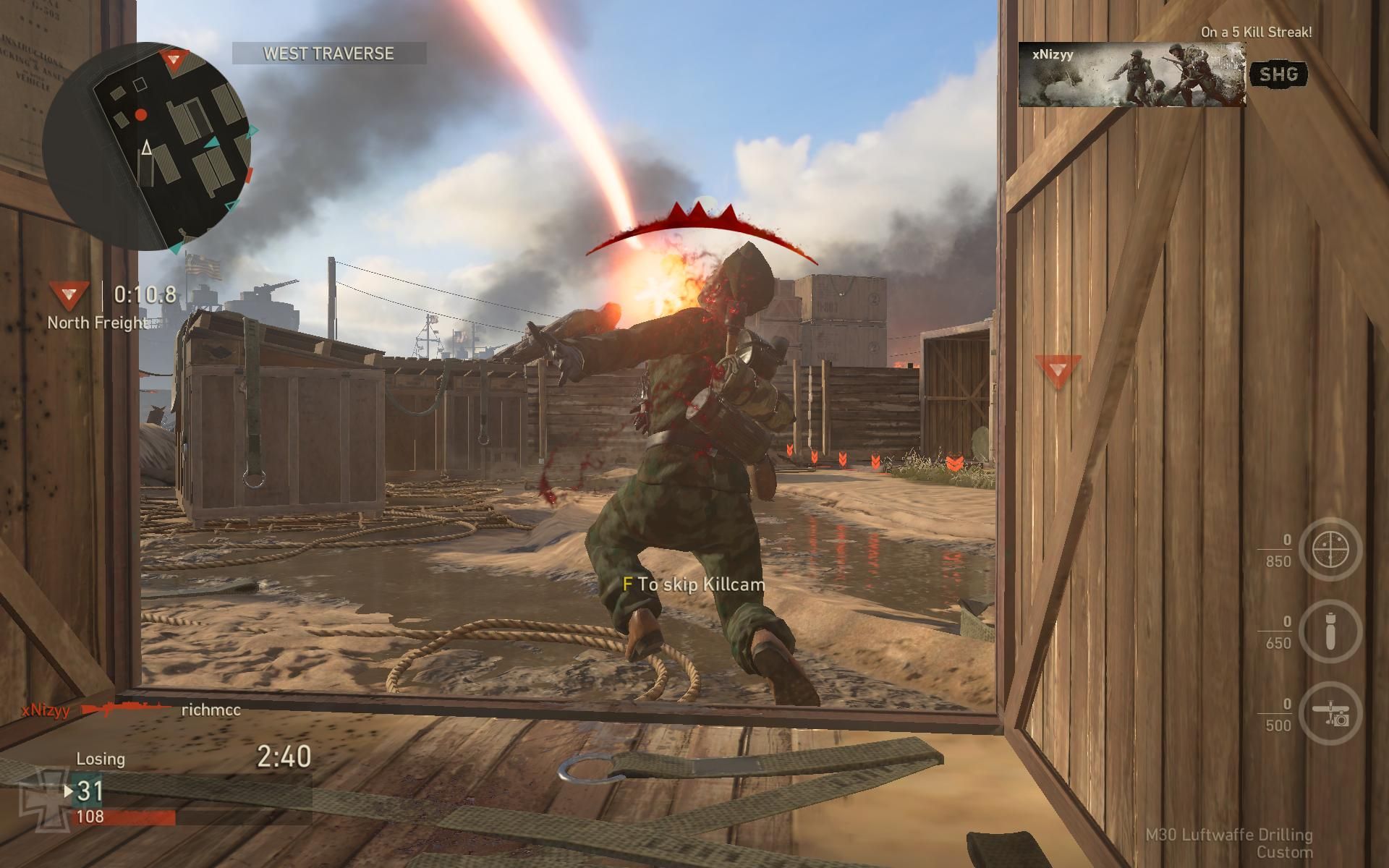Has Call of Duty: WW2 been improved by its updates?
A step back in time
After so many Warfares of the Modern, Advanced, and Totally Wacky variety, there was something comforting about Call of Duty going back to World War 2. Playing Call of Duty: WW2’s multiplayer mode now, nine months after launch, is like slipping on an old boot — albeit a boot covered in mud, masonry dust, and the blood of tens of millions of people.
It’s also fitting that a game about a conflict 70 years past feels so old. In 2018, and in direct comparison with competitors like Battlefield, CoD’s engine feels like it was of age to actually enlist for the Second World War. That’s a bit unfair, but I spent last month playing Quake, and it feels like it’s learned all the lessons Call of Duty hasn’t from the last 10 years of multiplayer shooters. There’s a decidedly unreconstructed feel to CoD: WW2’s breakneck pace, its rigid animations, and its dinky maps. Navigating those stages feels awkward, too: I kept getting stuck on walls and pieces of jutting rebar, and the edges of the maps are conspicuously constrained by crates and piles of insurmountable rubble. Broken bits of scenery jut into view at windows and low walls, both blocking bullets that shouldn’t be blocked, and letting them through when they should be stopping their path.
There’s almost no destruction, outside of the demolition of very specific walls and obstacles with plastic explosive. In fact, there’s barely any level interaction at all: soldiers skate across the surface of the muddy maps like they’ve been coated in teflon, the grime of the era just refusing to stick to their pristine uniforms.
These maps play host to a selection of modes. Domination is the same capture-and-hold of three flags from previous Call of Duty games; the popular Kill Confirmed asks players to collect the dog tags of the people they’ve shot, while Capture the Flag remains as it always has. Its freshest introduction is War mode, but even that — an objective-based battle between defending and attacking sides — saw action in mid-2000s titles like Wolfenstein: Enemy Territory. These modes are joined by other returning types, including Team Deathmatch and Search and Destroy, but they all boil down to two teams, shooting each other.
Fortunately, that shooting is one area Call of Duty has grown old gracefully. Bullets feel uniquely lethal in Activision’s series, each successful hit delivering an instant payoff thanks to violent little sound effects and an on-screen damage indicator — a cross, like a cartoon character’s dead eyes. Connecting with a salvo feels great from any gun, and doubly so if you score a headshot, the ping from which is the audio version of a pat on the back. I like the newly introduced De Lisle, a sniper rifle whose silenced bullets are quietly expelled from a barrel as big as a bottle of wine, but my favourite weapon remains the Lewis: a light machine gun with a pie-plate magazine and laser accuracy, even on the move.
Kills are quick and nasty, the game’s imaginary people dying with a soft “whuff” when shot through the lungs, or screaming horribly for their lives when set on fire by flamethrower. There’s so much death that I was quickly desensitised to it, hammering F to skip the CoD killcam that shows me how I died, eschewing valuable intel in the process. There’s never more murder than when you get the drop on an enemy team: clearing out a whole squad is more than possible with a single clip and some judicious aiming. These multi-kills are the quickest way to rack up high scores, racking up numbers that are in turn rewarded with bonuses if you hit certain limits before dying. These scorestreak rewards can be changed in the main menu, and include recon planes that show enemy movements on the minimap, controllable bombs dropped from AI aircraft, and mortar shells shot from offscreen: powerful tools that help the killy get killier.
But actually maintaining those scorestreaks is tricky when that low time-to-kill — a Call of Duty staple — also makes life on the other side of the ironsights much less enjoyable. Mid- to close-range gunfights are invariably decided by who saw who first, and the small maps, speedy sprint, and prevalence of hyper-accurate guns mean that battle lines are so blurred as to be non-existent in most game types. That meant an average minute with the game saw me spawn, get shot in the back, spawn again, shoot someone else in the back, and get shot (in the back) again. It’s such a manic experience that the closest I got to advanced tactics was hiding behind a bin while the enemy team sprinted full-pelt around the nearest corner: camping as the highest art of war.
That dynamic is less of a problem in War mode. War is CoD: WW2’s best game type, largely because the two teams tend to be facing each other for the duration of the battle, and its objectives tend to focus fights into clearly defined channels. Three new War maps have been added in CoD: WW2’s three DLC packs, but my favourite is still Operation Neptune, set on Normandy’s Omaha Beach. That’s in part for the nod to genre grandpappy Medal of Honor: Assault Assault, but also because the setting quantifies progress in a way that other modes don’t. Where matches of Domination or Free-For-All can feel aimless, Operation Neptune has clear goals: “get up the beach” for the Allies, “stop them getting up the beach” for the Axis.
Those clear rules and tangible progress markers make War the opposite of CoD: WW2’s Nazi Zombies mode. The mode has been a fixture in most Call of Duty games since World at War, but in this incarnation, it’s difficult to see exactly why it's still shambling along. Clearing wave after wave of the undead is a grinding, boring task, primarily because weapons — normally so killy in regular PvP mode — here feel blunted and useless. Headshots don’t land properly, at least until you’ve earned enough points to unlock better-tier weapons and upgraded them a few times. Stripped of that feedback loop, Nazi Zombies feels clunky and imprecise, especially during its first few waves.
That’s not to say the first waves are difficult — they’re more an exercise in tidying up — but each new match demands that players start again with a basic pistol and no points in their pocket. Getting a good enough gun is a significant time commitment, and there’s no guarantee that your team won’t just collapse like mouldy meat, ensuring you’re overrun in the mid-game and rendering the last 30 minutes of your time largely pointless. That’s assuming you even get the sweet release of undeath: I spent most of my time in the later waves spectating for minutes at a time as more experienced randoms kited endless strings of zombies around powerfully brown levels. Please, eat my brain — I can’t take another round.
Adding to the rotten taste in the mouth, Nazi Zombies is also the only place CoD: WW2 becomes a bit pay-to-win-y: players can buy consumables with real money and bring them into matches. These include nukes that kill all current zombies in a wave, charms that replenish ammo, or items that totally fill allies’ special ability meters. The loot crates containing these items also drop reasonably often from simply playing the game, but I ended up hoarding my best items jealously — too often I decided to lug a top-tier consumable into a game, only to have my matchmade team mates ditch the session a few seconds after I deployed it.
Nazi Zombies is co-op, so paying to win for one is at least, theoretically, paying to win for all. Still, though, I prefer CoD: WW2’s loot implementation in its regular multiplayer mode, where crates can only contain cosmetics. There are hundreds of these at this point in the game’s life, ranging from calling cards that frame a player’s name, to full outfits, to weapon skins and attachments that can change your boring crosshairs into the shape of two prancing unicorns. Regular updates and events — including July’s country-themed Liberty Strike — have bolstered the count of these cosmetics, adding country-themed jumpsuits that let players dress up like Russia’s version of Evel Knievel. They're fun enough additions, but I did question the viability of wearing some of the more gaudy outfits: they stick out like a shot thumb against the game's drab map backdrops.
It’s not just cosmetics added in these updates, though. Liberty Strike also brings three new guns and a “push knife,” which looks like the stabbier brother of brass knuckles and can be reskinned as a corkscrew if you’re feeling especially horrible. Bigger still was the introduction of the Cavalry class: an archetype that comes equipped with a bullet-deflecting combat shield as standard. They were only introduced in July, but Cavalry soldiers are already common sights in CoD: WW2’s battlefields. They function particularly well in War mode, where their shields can distract snipers and machine gunners, clearing paths for team-mates to take objectives.
That’s assuming your team-mates are playing the objectives in the first place. It might be because my playtime straddled a weekend where the game was free to play, but it seemed like half of my colleagues preferred to play as snipers, hanging back for individual glory rather than trying to complete the missions on offer. That free weekend may also be the cause of the toxicity I encountered — multiple matches were interrupted by voice and text chat complainers dropping racist and sexist slurs in their disparagement of both game and team — but I’m inclined to believe that it remains a problem in the community at large.
Those toxic team-mates led me to turn off CoD: WW2 faster than I would’ve liked, but even during anger-free sessions, it wasn’t long before my war had run its course. CoD’s combat is quick and classical, and its shooting remains superlative even after 10 years of action. But in a state largely unchanged for a decade, it’s also a touch too creaky to recommend over fancier, flashier, and more fun rivals.












